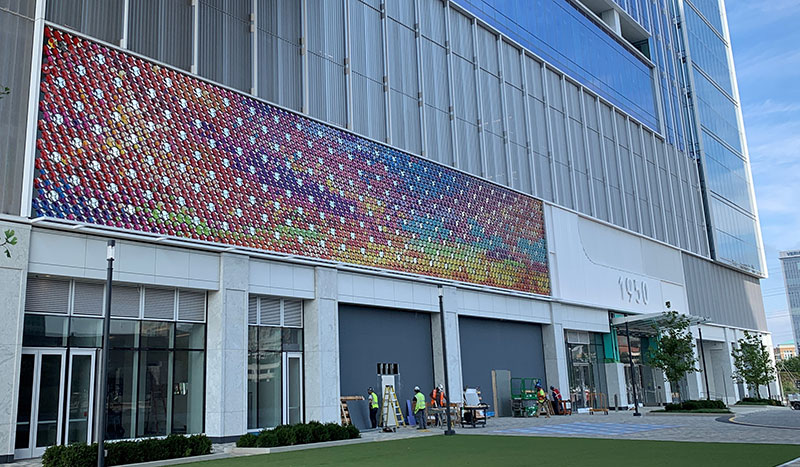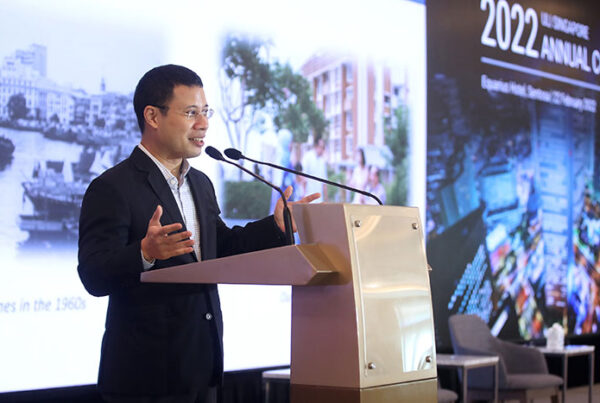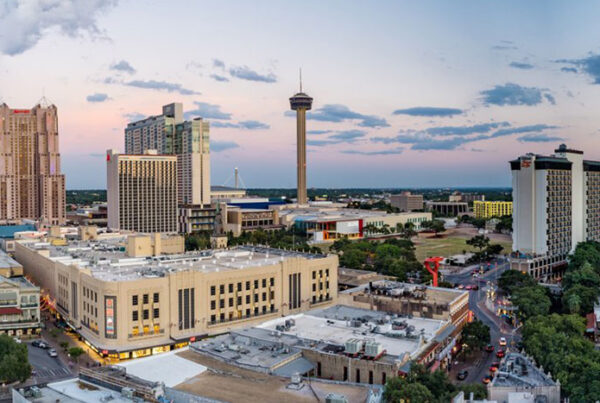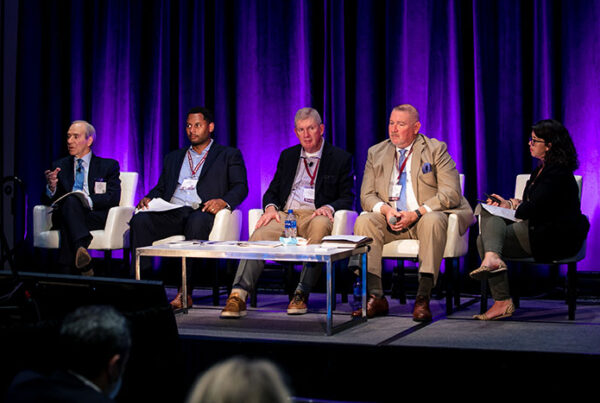
Where Land and Sky Meet, a wind-activated art wall by Dan Cheetham at Boston Properties’ Reston Town Center in Virginia. (Boston Properties)
Developing major new commercial real estate projects requires art and science to anticipate a market-need years before delivery and navigating complex neighborhood and regulatory hurdles. Atop those challenges, some jurisdictions tack on a percent-for-art spending requirement.
Public art, fueled both by percent-for-art requirements and by project sponsors who voluntarily commission such works, is a key part of the $19 billion in private sector giving to the arts, culture, and humanities, according to the Americans for the Arts’ 2018 survey, its most recent report. Percent for art programs, typically devoting 1 or up to 2 percent of an overall real estate project’s cost into art, are in place for all federal buildings, and required for private development in many U.S. states and in over 100 municipalities nationwide.
According to Toni Sikes, CEO of CODAworx, a leading U.S. public art resource group, “Americans overwhelmingly want more public art that makes their cities more livable and special, but it’s a challenge to find the funding. We hear from developers who embrace percent-for-art that it can be a great community connection building support for their new real estate projects, and goodwill at City Hall.”
Even as art requirements gain momentum in enhancing the public realm, developers are also getting smart about making public art work for the public, as well as for the project. Some sponsors also see public art within their own imperative to support the communities in which they operate, and differentiate the real estate in a new and compelling way.
“Art is important to many of us individually at Jay Paul Company,” said Matt Lituchy, chief investment officer of the Northern California real estate developer Jay Paul Company, “and our firm sees public art as a vital part of all our real estate developments, for the benefit of our tenants and for the community. Great public art has the power to engage and uplift all of us, and we spend a lot of time selecting and integrating it with projects where it makes sense.”

Silver Lantern, by Napa-based public art designer Gordon Huether, was added in September to Jay Paul Company’s new Silicon Valley office campus in Sunnyvale, California. (Gordon Huether Studio)
At Jay Paul’s new residential tower in San Francisco, 181 Fremont, art was not just a local regulatory mandate but was integrated extensively into earliest planning to help position the property among discerning buyers, many of whom are art collectors themselves.
181 Fremont’s Gallery 181, an on-site exhibition space offering contemporary exhibitions every eight to 12 weeks, is open to the public by appointment and is available for use by non-profits, cultural organizations, and private events. The property also has acquired a significant number of works for a permanent collection featured throughout the building.
In Silicon Valley, the firm’s two newest office buildings in Sunnyvale, California, are installing ground-plane public art designed to differentiate the properties among high-tech and bio-tech firms competing for knowledge workers. Designed by large-scale public artist Gordon Huether, the two gateway installations include Silver Lantern, a 17-foot-high sculptural evocation of light reaching skyward at 625 North Mathilda and Spectorium, a 16-foot-high dichroic glass organza of color at 465 North Mary.
“Public art can accomplish a great deal, both for those that see and enjoy it but also for the business objectives of real estate owners,” said Huether, a long-time Napa, California, resident with artworks throughout the U.S. “Sculpture, lobby art and integrated-architecture programs are for enjoyment, but they can also visually brand the building or campus, support leasing and entitlements, complement landscape design and perform day-to-day functions such as wayfinding.”
At a time when companies are re-engaging employees who’ve become used to the work-from-home/work-from-anywhere option, art can be one of many components of an engaging, stimulating, high-productivity workplace.
A 2003 study by the Business Committee for the Arts and the International Association for Professional Art Advisors surveying 800 employees from 32 organizations found art has significant positive influences: 78 percent agreed art helps reduce stress, 67 percent agreed art helps increase morale, 64 percent agreed that art helps increase creativity & productivity and 73 percent agreed art helps to build community relationships.
A 2010 University of Exeter study compared productivity in two groups of employees with an hour’s worth of administrative tasks, one in an office with art and plants and the other in an environment without any additional decoration. The results revealed that employees in the office with art and plants work 15 percent faster than those in unadorned offices.

The Canyon is a 300-foot art work at Salt Lake City’s new airport terminal by Gordon Huether in conjunction with building designer HOK. (Salt Lake City Airport)
In Salt Lake City, Huether’s massive 230-foot-long The Canyon is an undulating, sweeping art installation of canvas over steel ribbing that was integrated into the interior walls of a new airport terminal in collaboration with architecture firm HOK. A CodaWorx 2021 public art award winner, The Canyon also uses a sophisticated day-to-night lighting scheme that complements the airport commission’s goals of helping visitors easily identify the grand arrival/departure hall and to market Utah’s natural geographic wonders to over 2 million passengers who are passing through — and potentially returning as tourists.
Outside Washington, D.C, Boston Properties recently debuted a large-scale public artwork that takes wayfinding and project-identity to a whole new level.

A close up of Where Land Meets Sky recently installed in Reston, Virginia. (Boston Properties)
The developer’s newest phase of Reston Town Center had both an art requirement to fulfill, but also had the opportunity to create a visual icon to engage visitors and brand the project — for miles around, according to Matt Bonifant, project manager for Boston Properties.
Where Land and Sky Meet by Austin, Texas, artist Dan Cheetham, is a 2,500 square-foot (232.25 sq m) “art wall”, as it’s been dubbed, screening a portion of the parking garage above the new development’s main plaza. “It was thoughtfully designed to create a unique experience whether being appreciated through amazing view corridors nearby, or up close at a pedestrian level,” said Bonifant.
The artwork includes nearly 2000 colored and mirrored disks across its face, and each has a tiny wind turbine with a custom ball bearing assembly so that the wind activates the disks to bring a sense of air waves rippling across the art.
“If there’s a significant wind event, the entire … surface is activated, while on other days in light wind, some areas are moving differently than others in unique and localized patterns,” said Bonifant. “For repeat visitors or area residents, you see an entirely different piece of art depending on the weather, the light by day or moon-lit sky, or other variables. It’s distinctive, memorable and ties beautifully to our desire for a timeless installation that highlights our pedestrian-oriented public plaza and the entire mixed-use community.”
Boston Properties engages artists early, to better integrate to project goals, wherever possible, said Bonifant. “Contemplating the art components at inception helps you plan for and achieve objectives, and to anticipate challenges,” he said. “With this installation, we wanted something relevant to the locality and region, and the art wall is a strong visual reference to the nearby Blue Ridge Mountains while also reflecting the beauty of nature, wind and weather.”
“Like so many moving parts in the development, public art can accomplish more when it’s part of the process,” he concluded.
Research supports the notion that public art should complement and support the built environment. A 2019 survey by NINEdotARTS of executives and managers in real estate development, architecture, healthcare and hospitality found that almost two thirds – 62 percent – of respondents said that it’s “absolutely critical” or “very important” that art in the workplace expresses a company’s brand, mission, and vision.
“The trick for successful public art is that, if you can work with the artist early in the concept stage, it’s more gratifying for everyone to create something that uplifts, engages and stimulates while also accomplishing business objectives,” said Huether. Another trick of the trade: Make sure the art engagement provides for the full spectrum of design and installation such as a design-build approach.
“Artists can add much more value with a partnering approach by developers, architects, even planners and landscape architects,” he said, “whether the goal is for a branding icon for the space, or to be awe-inspiring, or quietly reflective, or deeply emotionalor perhaps just creating something to make you smile.”



